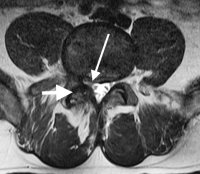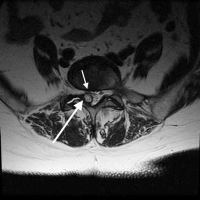An Overview of Lateral Recess Stenosis
Lateral recess stenosis is a common form of nerve root compression from the narrowing of a nerve root channel in the lower back. The lateral recess is the location of the transitioning nerve root. This area is bounded by the pedicle laterally, the disc anteriorly, the spinal canal medically and the facets posteriorly.
The lateral recess can be compressed by a disc herniation or spur from the disc endplate in the front, a facet spur from behind, a ganglion cyst off a degenerative facet and from a translation of one vertebra on the other as in a degenerative spondylolisthesis.
Lateral Recess Stenosis Symptoms
The symptoms of lateral recess stenosis are of positional nerve pain (leg pain). Unlike a disc herniation (which causes leg pain with sitting that improves with standing) or foraminal stenosis (which causes leg pain with standing that is relieved by sitting), lateral recess stenosis can cause leg pain in any position. The patient sometimes has to contort like an acrobat to try and gain some relief of the leg pain.
The reason for this contortion is that the lateral recess changes in volume with spinal position. Bending backwards (extension) causes the area to narrow and the nerve root can become pinched. Bending forward can stretch the root over a spur or herniation in front, which also can compress the root.
This condition is also known as subarticular stenosis. The articulation in the lower back is facet joint and if you have read this web site, you will know that any joint in the lower back can become degenerative. Degeneration can cause bone spur formation (a process called an enthesopathy) and occasionally, this bone spur can grow into the lateral recess.
Are you suffering from symptoms of lateral recess stenosis?
Would you like to consult with Dr. Corenman about your condition?
You can set up a long distance consultation to discuss your
current X-rays and/or MRIs for a clinical case review.
(Please keep reading below for more information on this condition.)
Lateral Recess Stenosis Treatment
Treatment of lateral recess stenosis is similar to treatment of a herniated disc. Physical therapy or chiropractic is started first. If relief is found, continued self-guided home exercises are performed. If the symptoms are not relieved with these measures, epidural steroid injections are then used (see website for description). Finally, if symptoms continue or motor weakness is noted, a surgical decompression is then used to open the lateral recess. Fusion is typically unnecessary to treat a lateral recess stenosis.
For additional information on lateral recess stenosis, or to discuss the cause of your lower back pain with a back doctor and spine specialist in the Vail, Aspen, Denver and Grand Junction, Colorado area, please contact Dr. Donald Corenman.
Related Content
- When to Have Lower Back Surgery
- Causes of Lower Back Pain
- Normal Spinal Alignment
- Lumbar Spinal Anatomy
- How to Describe Your History and Symptoms of Lower Back and Leg Pain
- Best Questions to Ask When Interviewing a Spine Surgeon or Neurosurgeon
- Degenerative Spondylolisthesis
- Isolated Disc Resorption-Lumbar Spine (IDR)
- Lumbar Spinal Stenosis (Central Stenosis)

(Click to Enlarge Image) Normal axial lumbar MRI of L4 5. Arrow points to open lateral recess with nerve root (black dot) free and uncompressed.


